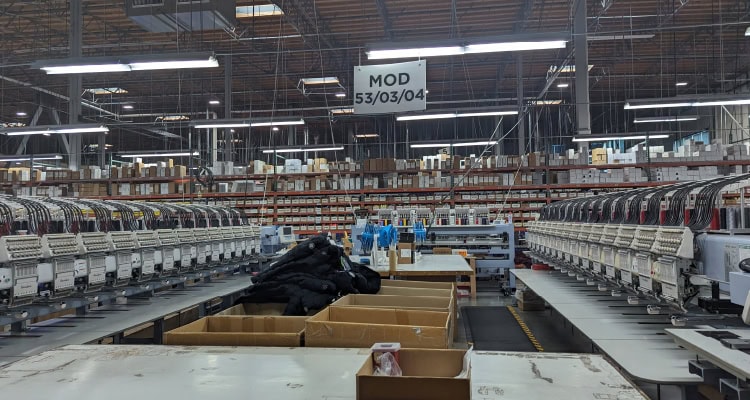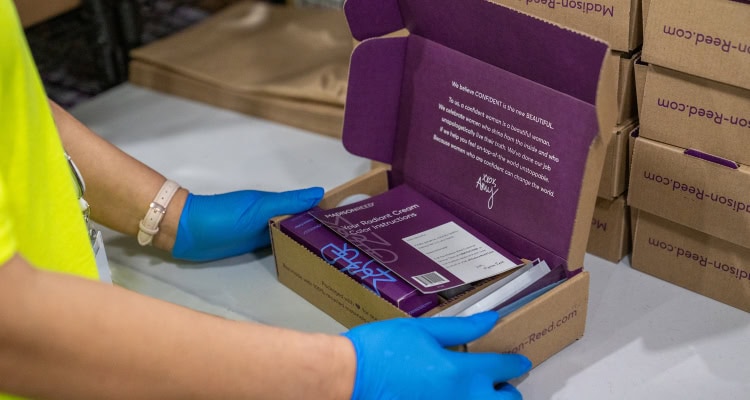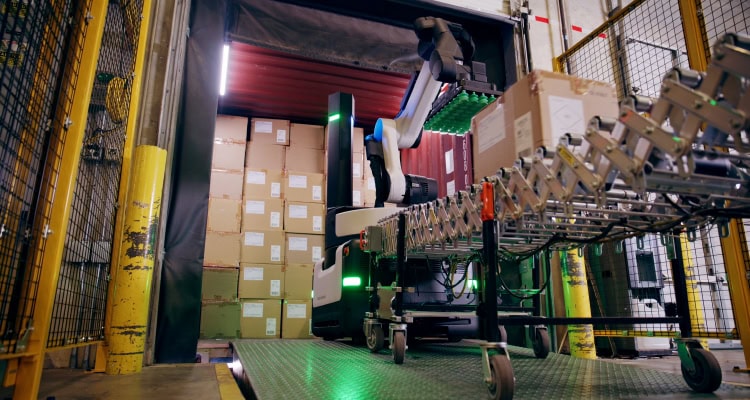A Sense of Fulfillment

Reflecting on ways to sharpen fulfillment operations and keep up with growth? Ease your mind by partnering with experienced providers.
Robust growth is a goal for just about every company. That same growth can create chaos, however, if a company is not equipped to accommodate it. When customer demand intensifies, many manufacturing companies struggle to elevate their fulfillment operations to keep up with it, whether they face a seasonal or ongoing jump in orders. Not being able to adequately adjust can undermine the rest of their business.
Manufacturers who feel the pressure of ramped-up demand often turn to third-party providers to transform their fulfillment operations. In the following company case studies, fulfillment stopped acting as an obstacle to growth and started serving as an integral aid to it.
Cutter & Buck: Tackling Seasonal Demand Surges

The use of AutoStore reduced Cutter & Buck’s order turn time for direct-to-consumer orders by two days, while labor needs dropped 60%.
Cutter & Buck, a sportswear and golf apparel manufacturer based in Renton, Washington, had a pressing problem. During the 2021 holiday season, the company could not hire enough labor to ship orders within two to three days, even though its goal was to ship all orders the same day they were received.
“We had run out of space in our active locations in our three-floor pick module, and we were unable to keep our standard turn times during peak season,” recalls Scott Sumpter, the company’s executive director.
The challenge became so severe that Cutter & Buck flew in salespeople to help in the warehouse, and the company’s CEO and CFO pitched in to help pick and ship orders.
Cutter & Buck knew it needed to improve its fulfillment process, and it sought an automation solution to help. The company turned to Kardex, a Switzerland-based industry partner for intralogistics solutions and a supplier of automated storage solutions and material handling systems.
Kardex implemented AutoStore, an automated storage and retrieval system that uses warehouse robots for fulfillment. Cutter & Buck signed with Kardex in spring 2022 with a plan to go live with AutoStore in August 2023.
Cutter & Buck had increased sales through the web and its brick-and-mortar channels, leading to consistent company growth and increased inventory levels, explains Mitch Hayes, president of Kardex Solutions AutoStore. For the company to accommodate that growth, it needed a strategic shift to automation.
Kardex spent time at Cutter & Buck’s fulfillment center in Seattle to understand the business and process flows. The apparel manufacturer shared its data from peak season 2021, when the starkest problems had occurred, as well as its five-year growth plan.
Kardex’s help went beyond preparing to implement AutoStore. “They also identified some areas we could improve to get through peak 2022 before AutoStore would be implemented,” Sumpter says.
Despite some inherent complexities, the AutoStore implementation went according to plan.
“Because we were building AutoStore in an area that was covered with racking and conveyors, both of which were integral to our daily process, we faced some significant challenges along the way,” Sumpter says. “We are fortunate to have a great team who bought into the future, and they all went the extra mile to keep us on schedule.
“Kardex made their part look easy,” he adds. “We went live on August 5, the day we had planned 15 months earlier.”
Evident Benefits
“Kardex projected we would get through the 2023 holidays with 18 fewer people in the stocking and picking roles and that is exactly what we did,” Sumpter says. “We eliminated our bottlenecks, and we were able to continue to ship product the same day, every day.”
Cutter & Buck shipped 13% more units during the 2023 peak season versus the same period in 2022 with shorter lead times and less labor, Hayes says.
In particular, for AutoStore’s specific tasks, labor needs decreased 60% from 30 to 14, and the total labor per unit dropped 35% from 53 to 35 in one year.
AutoStore’s capabilities enabled 50% growth in the direct-to-consumer channel, according to Hayes. The solution also reduced the turn time of direct-to-consumer orders by two days. The lead time for embroidery orders is now 29 hours, and undecorated orders ship the same day up to 2 p.m.—a metric that remained in place during the most recent peak season.
Overall, Cutter & Buck’s most recent turnaround time is 25 hours—a striking improvement from the previous turnaround time of three to five days.
Sumpter says he sees a promising future for Cutter & Buck’s continued use of AutoStore.
“We are testing the latest update that will allow us to change the language on individual ports,” Sumpter says. “We have a significant Vietnamese population on our team and this will allow easier and quicker training for non-English-speaking employees, but honestly, it isn’t that hard now.
“AutoStore also plans to introduce LiDAR sensors around the port that will eliminate touching the monitor,” he adds. [LiDAR, or Light Detection and Ranging, emits rapid light pulses at an object or the surrounding environment, and the amount of time it takes for the light to return is then measured.] “That will improve ergonomics and speed for our team.”
Madison Reed: Enhancing Fulfillment to Meet Demand Goals

Saddle Creek supports all of Madison Reed’s sales channels from a single inventory, providing the hair beauty brand with accurate stock counts at all times.
Madison Reed is a San Francisco-based beauty brand that offers more than 55 shades of hair color through a variety of channels, including direct-to-consumer sales and more than 90 Hair Color Bars around the country.
The Hair Color Bar concept has experienced rapid growth, and the brand also is expanding its wholesale business through retail partnerships at Ulta, Ulta at Target, Target, and Walmart.
On top of all that, Madison Reed launched on Amazon and is expanding quickly there.
In light of that growth and the complexity of Madison Reed’s channels, a strong fulfillment operation is critical, says Erica Brooner, the company’s vice president, supply chain. However, fulfillment was hindering its ambitions for a while.
“We were facing challenges with unreliable service levels and performance, inaccurate inventory, and retail compliance issues,” Brooner says. “We had an unreliable logistics partner that did not have best practices in place across all aspects of fulfillment and distribution, and we were in dire need of that.
“When customers color their hair, they want the product to show up when they need it so they can stay on their desired schedule, so consistency is definitely key,” Brooner adds. “It’s also important on the Hair Color Bar side because disruption not only affects sales, but also affects our ability to perform services in those salons.”
Finding the Right Partner
Brooner says Madison Reed’s stockouts were trending at 8 to 10% due to a variety of reasons, mostly lack of reliable inventory visibility and inventory accuracy. In response to its fulfillment struggles, Madison Reed ran a competitive RFP process that led to Saddle Creek Logistics, an omnichannel supply chain solutions company based in Lakeland, Florida.
Saddle Creek spent time with Madison Reed’s team discussing its needs and expectations and then assembled a cross-functional solution design team made up of experts in engineering, systems, and operations, as well as senior management. The partnership ultimately led to a single-node solution with dedicated space at Saddle Creek’s Fort Worth, Texas facility. The operation went live in October 2023.
“Saddle Creek supports all of Madison Reed’s sales channels from a single inventory,” says Luke Hendrix, regional senior director, operations, Saddle Creek Logistics Services. “For the core business, base kits are kitted to stock and the UPC label is applied. Then, the kits move to work cells where we add hair color, marketing inserts, and any add-ons. We ‘each pick’ ecommerce orders and orders for the Hair Color Bars and case pick orders going to retailers like Ulta and Target. To ensure order accuracy, we perform quality checks at the end of every line.”
Madison Reed operates on Saddle Creek’s order management system (OMS) and warehouse management systems, and will continue to refine and enhance the operation as needed.
Brooner says Madison Reed found “real value” in Saddle Creek’s work cell design. “It was unlike anything we saw from other prospective partners,” she says. “We knew it could create efficiencies to help with volatility in demand and order volume as well as our focus on picking accuracy.
“We did not have an OMS prior to our relationship with Saddle Creek,” she adds. “Their OMS functionality introduced a different level of visibility and, specifically, inventory allocation.”
Brooner notes that Madison Reed now has an allocation-driven inventory process that ensures the company passes fully executable orders to the team on the floor.
“As a result, we don’t have surprise shorts or cancellations where we’re not able to deliver product to our customers,” Brooner says.
Always Accurate
The move to a single-node solution with dedicated space, alongside Saddle Creek’s processes and cycle count accuracy, means that Madison Reed maintains accurate inventory at all times, Brooner says.
“We have brought down shorts and cancellations on the wholesale side of our business to nearly 0%,” Brooner says. “We reached 100% OTIF [on-time-in-full] shortly after joining Saddle Creek—which is a complete 180-degree turn from where we were before.”
As of April, Saddle Creek has supported the opening of five new Hair Color Bar locations in 2024—each with launch orders shipping in the first quarter to support openings shortly afterward.
“Our Hair Color Bar leadership said it is the first time that they have received all the product required to make sure the stores look great and actually start performing services on time, all without disruption or hiccups,” Brooner says.
For both Cutter & Buck and Madison Reed, finding the right partner was the key to turning their fulfillment operations around and freeing them to pursue the growth their brands were ready to enjoy.
A Fulfilling Partnership

It’s not only shippers who turn to providers to strengthen their fulfillment operations—providers themselves also work with fellow providers to improve how they serve their shipper clients.
In one such collaboration, DHL Supply Chain has begun to deploy Boston Dynamics’ Stretch Robot to unload cartons from trucks at its fulfillment facilities. The robots remove packages from the back of trailers and place them on a flexible conveyor.
Automating the process with robots not only addresses safety concerns but also helps tackle the ongoing labor supply challenge by redirecting skilled labor to focus on value-add, strategic tasks in other areas of the warehouse. Stretch’s case upload speed is faster than a manual approach, creating efficiency and productivity improvements.
DHL and Boston Dynamics started collaborating on the project in 2019, and DHL first deployed Stretch in January 2023. Trailer unloading was an apt place to focus the work from a robotics standpoint.
“There are enough constraints with the safety requirements that allowed us to zero in on what a potential solution could be,” says Andre Brueckner, Stretch product manager at Boston Dynamics. “The process of iterating through getting a prototype working, then working through testing, and ultimately launching allowed us to get Stretch to a point today where it is productive and valuable at the warehouse for DHL.”
A key innovation that makes the Stretch Robot so effective is its ability to pick multiple boxes at the same time, Brueckner says. Also important is an intuitive, streamlined interface that allows workers to pick up the operation of the Stretch rapidly, ensuring it is an “uninterrupted” member of the team when turnover occurs.
DHL and Boston Dynamics currently are working together to not only refine and improve on the early success that it has seen with trailer unloading, but also to explore the value of adapting Stretch for future applications within DHL’s warehouses and to ask questions such as: “How small can the cases get? How large? How awkward?”
“We’ve continued to roll out the robot and expand its presence in our facilities,” says Matthew Dippold, director of accelerated digitalization at DHL. “We have been able to reduce injury rates, reduce turnover, and improve predictable flow into the building with the robot. So we continue to push it out into our facilities, and we continue to learn from it.”
